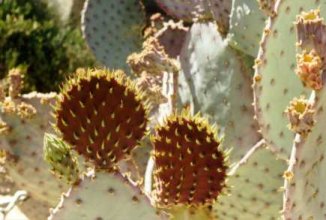|
 OPUNTIA. Opuntia sp. Brasiliopuntia sp. Consolea sp. Corynopuntia sp. Cylindropuntia sp.
Ficindica sp. Micropuntia sp. Nopalaea sp. Candelabrum Cactus, Coyote Candles, Velas de Coyotes.
Takic: Mutal. Only Opuntia have glochids. Glochids are an ingredient in itching powder. In this genus alone, young
pads have tiny leaves. Opuntia with cylindrical joints are called Cholla. Those with flat joints are called
Prickly Pear. Flat pads are eaten raw or cooked. Pads and fruit are sold. Luther Burbank attempted to develop a
spineless form as livestock and human food. For some reason, cacti tend to resist fire. They form a ring of
protection around themselves. Plant Opuntia around the perimiter of your house far enough back so that a forest
or desert fire cannot get up under the eaves. In case of such a fire, a house is most likely to burn if the fire
can get under the eaves. Cattle will eat spined cholla when other food is scarce. To remove a joint, slip a comb
under it and pull.
OPUNTIA. Opuntia sp. Brasiliopuntia sp. Consolea sp. Corynopuntia sp. Cylindropuntia sp.
Ficindica sp. Micropuntia sp. Nopalaea sp. Candelabrum Cactus, Coyote Candles, Velas de Coyotes.
Takic: Mutal. Only Opuntia have glochids. Glochids are an ingredient in itching powder. In this genus alone, young
pads have tiny leaves. Opuntia with cylindrical joints are called Cholla. Those with flat joints are called
Prickly Pear. Flat pads are eaten raw or cooked. Pads and fruit are sold. Luther Burbank attempted to develop a
spineless form as livestock and human food. For some reason, cacti tend to resist fire. They form a ring of
protection around themselves. Plant Opuntia around the perimiter of your house far enough back so that a forest
or desert fire cannot get up under the eaves. In case of such a fire, a house is most likely to burn if the fire
can get under the eaves. Cattle will eat spined cholla when other food is scarce. To remove a joint, slip a comb
under it and pull.
O. karwinskiana: Nopalillo. Exotic. It has pharmacological properties. Use the root interally, in an infusion,
against dysentery, diarrhea, hemoptysis and metrorrhagia.
The photo on this page is of a Prickly Pear.
See Cholla,
Prickly Pear.

|

